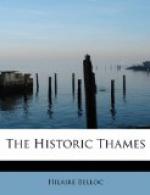Just as this bridge came later than the Bridge at Henley, so it was inferior to it in structure; it was, as we have seen, of timber, but such as it was, it was the cause of the growth of Maidenhead much more than was the bridge at Henley the cause of the growth of Henley. The first nucleus of municipal government grows up in connection with the Bridge Guild; the Warden and the Bridge Masters remain the head of the embryonic corporation throughout the sixteenth and seventeenth centuries, and even when the town is incorporated (shortly before the close of the seventeenth century), by James II., the maintenance and guardianship of the wooden bridge remained one of the chief occupations of the new corporation.
It was just after the granting of the Charter that the army of William III. marched across this bridge on its way to London, an episode which shows how completely Maidenhead held the monopoly of the Western road. The present stone bridge was not built to replace the old wooden one until the last quarter of the eighteenth century, parallel in this as in everything else to the example of Henley; and this position of inferiority to Henley, and of parallel advance to that town, is further seen in the statistics of population. In 1801, when Henley already boasted nearly 2000 souls, Maidenhead counted almost exactly half that number. The later growth of the place is quite modern.
The antiquity of the crossing of the Thames at Cookham is supported by a certain amount of pre-historic evidence, worth about as much as such evidence ever is, and about as little. Two Neolithic flint knives have been found there, a bronze dagger sheath and spear-head, a bronze sword, and a whole collection or store of other bronze spear-heads. Such as it is, it is a considerable collection for one spot.
Cookham has not only these pre-historic remains; it has also fragments of British pottery found in the relics of pile dwellings near the river, and two Roman vases from the bed of the stream; it has further furnished Anglo-Saxon remains, and, indeed, there are very few points upon the river where so regular a continuity of the historic and the pre-historic is to be discovered as in the neighbourhood of this old ford.
In was in the course of the Middle Ages, and after the Conquest, that new Windsor rose to importance. It is not recognised as a borough before the close of the thirteenth century; it is incorporated in the fifteenth.
Reading certainly increased considerably with the continual stream of wealth that poured from the abbey; it possessed in practice a working corporation before the Dissolution, was famous for its cloth long before, and had become, in the process of years, an important town that rivalled the great monastery which had developed it; indeed it is probable that only the privileges, the conservatism, of the abbey forbade it to be recognised and chartered before the Reformation.
Abingdon also grew (but with less vigour), also had a manufactory of cloth, though of a smaller kind, and was also worthy of incorporation at the end of the Middle Ages.




